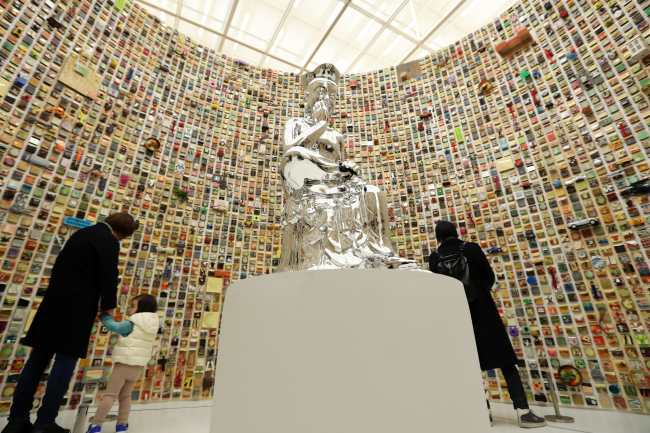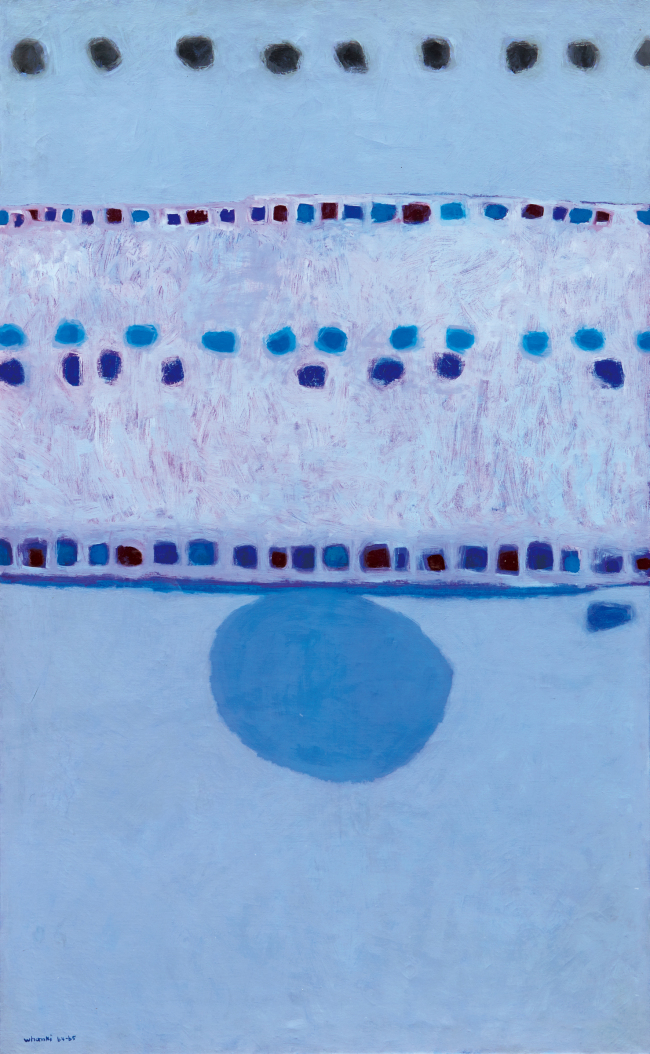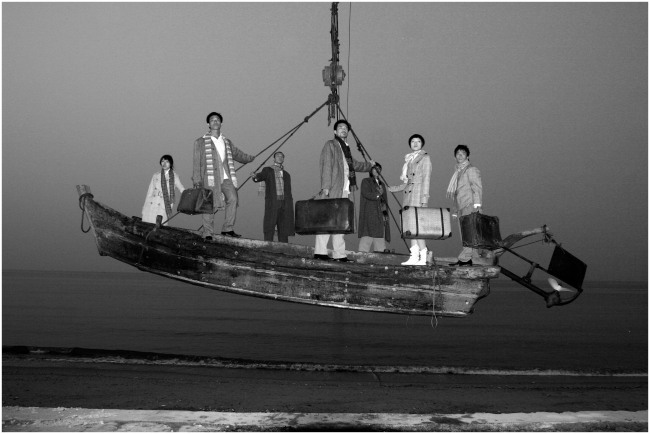The National Museum of Modern and Contemporary Art, Korea is showcasing its shopping bag, exhibiting a selection of its purchases and acquisitions from 2013 to 2016 at its Seoul branch.
The title of the exhibition, “Samramansang: From KIM Whanki to Yang Fudong,” is appropriated from New York-based Kang Ik-joong’s “Saramansang,” which stands majestic at the entrance of the show.
It is apt as “samramansang” can be interpreted as “all things and phenomena of the universe” and can hence be taken to refer to the immense diversity of contemporary art and the vast range of artistic expression of its practitioners.
Unlike typical exhibitions in which a theme is decided upon before pieces are curated, the current exhibition, which runs until Aug. 13, is arranged to reflect on the aesthetics of the times and the historic significance of the works.
A total of 121 pieces from 932 works, ranging from painting, sculpture and installation to video and film, are on view.
 |
Kang Ik-joong’s “Samramansang” is seen at the National Museum of Modern and Contemporary Art, Korea in Samcheong-dong, Seoul, Wednesday. (Yonhap) |
The museum’s first Kang acquisition, “Samramansang” is a collection of some 10,000 canvases, each measuring 7.62 by 7.62 centimeters, arranged in a cylindrical shape with a narrow opening that allows one to two persons to pass through at one time. Inside, a small universe of an eclectic mix of colors, images and objects unfolds, and sitting at the center of that chaotic universe is the statue of a pensive Buddha meditating, looking ever so calm and composed, detached from the surrounding cacophony.
The exhibition is also the state museum’s report on its shopping sprees, an account of how it has spent its shopping allowance.
Last year, the MMCA splurged more than 1 billion won ($885,270) on Dansaekhwa -- or monochrome painting -- artist Kim Whan-ki’s “Dawn #3.”
 |
Kim Whan-ki’s “Dawn #3” (MMCA) |
Bought at an auction, it is the most expensive purchase MMCA has made to date. “Our annual purchase budget exceeded 5 billion won for the first time last year and we bought Kim Whan-ki’s ‘Dawn #3,’” said Park Mi-hwa, an MMCA curator, during a press tour of the exhibition Wednesday.
The museum’s buying budget last year was 5.3 billion won while the budget for this year has been set at 6.1 billion won.
Created between 1964-1965, the oil on canvas piece is one of the 14 pieces Kim submitted for a special exhibition at the Sao Paulo Biennale in 1965. It is one of Kim’s early abstract paintings from his New York years, showing the influences of American abstract expressionist artists such as Adolph Gottlieb.
No exhibition that purports to reflect on the historical significance of works in Korea is ever complete without works that deal with the division of the Korean Peninsula and the current exhibition has a special section dedicated to the theme.
The lushness and the apparent calm of the DMZ as captured in Kim Atta’s eight-hour exposure photo belies the reality of the taught tension of the inter-Korean border. “Invitation,” a small oil painting by Jeon Seon-taek who settled in Taegu in his 20s after leaving his hometown in today’s North Korea, is a poignant reminder of the tragedy of separated families. A forlorn table facing the sea set with a bottle of drink, a snack, glasses and a pack of cigarettes waits for the day the nonagenarian artist reunites with his family.
In 2015, the museum focused on strengthening its new media genre, collecting 34 works of new media, a number of which are shown at the exhibition. Among the highlights in this category are Chinese video artist Yang Fudong’s “Seven Intellectuals in Bamboo Forest III” and “Seven Intellectuals in Bamboo Forest IV.” The two films, each more than an hour long, are from the five-part “Seven Intellectuals in Bamboo Forest” created from 2003 to 2007.
 |
A scene from Chinese video artist Yang Fudong’s “Seven Intellectuals in Bamboo Forest IV” (MMCA) |
“Seven Intellectuals in Bamboo Forest” refers to the seven intellectuals of the Wei and Jin Dynasties in China who gathered in a bamboo forest to escape a corrupt society. Yang appropriated the concept of intellectuals feeling the effects of a corrupt society, setting the black-and-white films in the 1950s and ’60s China. The work shows a group of five young men and two women who set about on a journey, discovering in the process what today’s people have lost and what needs to be preserved for future generations.
“We tried to get part I and II on loan so that they could be watched together but were unable to obtain them,” said curator Park.
Exhibitions often require several visits to be fully appreciated and “Samramansang” is no exception. As most of the new media works and films are lengthy, visitors might consider making separate visits just for the films. If you are lucky, you might be able to grab a seat, which Park described as “the most comfortable seats we could find.”
By Kim Hoo-ran
(
khooran@heraldcorp.com)










